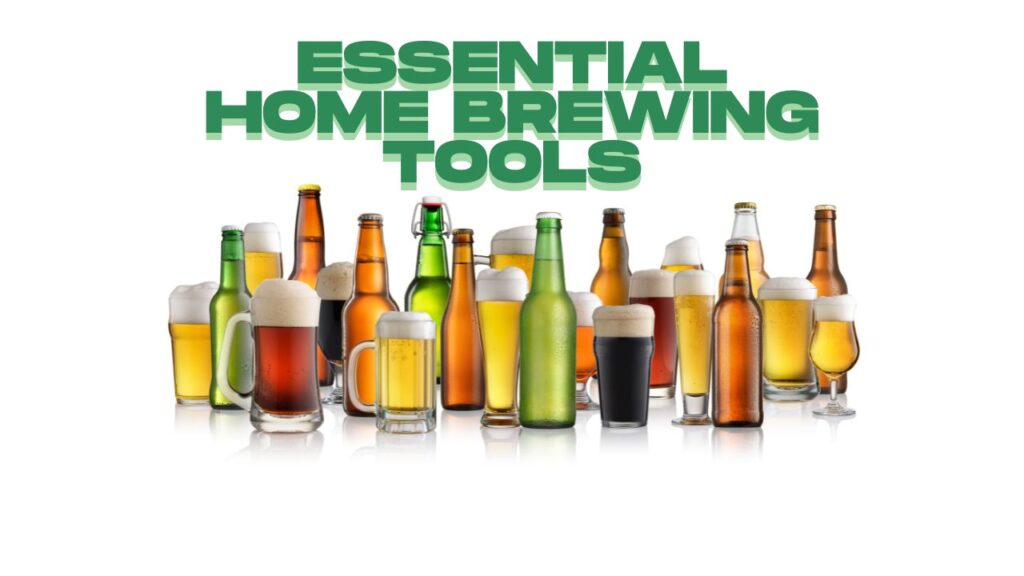
🛠 The Beginner’s Guide to Essential Home Brewing Tools
So, you’ve decided to step into the world of home brewing. Fantastic choice—there’s nothing quite like pouring a glass of beer that you made. But before the hops hit the kettle, you’ll need the right tools. This guide breaks down the essentials, with notes on size, materials, and experience level to help you make smart choices.
Brewing Kettle (a.k.a. Your Beer Cauldron)
- Purpose: Where the magic begins—boiling water, malt extract, hops, and other ingredients.
- Size: Minimum 5 gallons for beginners; 8–10 gallons recommended if you plan to move beyond simple extract brewing.
- Material: Stainless steel is best (durable, doesn’t react with ingredients). Aluminum is cheaper but requires careful cleaning.
- Experience Level: Beginner-friendly. If you can boil pasta, you can handle this.
- Pro Tip: Go bigger than you think—you’ll thank yourself when foam tries to boil over.
Fermenter (the Beer Nursery)
- Purpose: Where yeast works its magic, turning sugary wort into glorious beer.
- Options:
- Plastic Bucket (6–7 gallons): Cheap, light, and easy to clean.
- Glass Carboy (5–6.5 gallons): Classic choice, doesn’t scratch, but heavy and breakable.
- Stainless Steel Fermenter (6+ gallons): Premium choice—easy to sanitize, durable, but pricier.
- Experience Level: Beginner to advanced. Buckets are easiest for newbies.
- Pro Tip: Always choose a fermenter slightly larger than your batch size to avoid “yeast geysers.”
Airlock & Bung (The Beer’s Breathing Tube)
- Purpose: Lets CO₂ escape during fermentation without letting bacteria sneak in.
- Type:
- 3-piece airlock (easy to clean, beginner-friendly).
- S-shaped airlock (less cleaning, slightly slower gas release).
- Experience Level: Beginner. Just fill with sanitized water and let it burble.
- Pro Tip: The sound of your first airlock bubbling is the happiest gurgle you’ll ever hear.
Hydrometer & Test Jar (Your Beer’s Report Card)
- Purpose: Measures sugar levels before and after fermentation to calculate alcohol content (ABV).
- Size/Material: Standard glass hydrometer + plastic or glass test jar.
- Experience Level: Intermediate. Easy to learn but requires careful handling.
- Pro Tip: Always sanitize your hydrometer before dunking—contamination is the #1 rookie mistake.
Siphon & Tubing (Beer’s Escape Route)
- Purpose: Transfers beer from one vessel to another without stirring up sediment (trub).
- Types:
- Auto-siphon (best for beginners—just pump once to start flow).
- Manual siphon (old-school, a bit messier).
- Material: Food-grade plastic tubing (clear, 3/8” diameter is common).
- Experience Level: Beginner to intermediate.
- Pro Tip: Keep tubing dedicated only to brewing—kitchen hoses can ruin a batch.
Bottle Capper & Caps (Your Beer’s Security Seal)
- Purpose: Seals bottles so carbonation can build.
- Types:
- Handheld “wing” capper (affordable, beginner-friendly).
- Bench capper (stable, faster, but bulkier).
- Caps: Standard 26mm crown caps; oxygen-absorbing caps are great for longer storage.
- Experience Level: Beginner.
- Pro Tip: Always buy extra caps—you’ll drop a few (or lose them under the fridge).
Bottles (The Beer’s Final Home)
- Purpose: Stores and carbonates your finished beer.
- Size: Standard 12 oz bottles, or 22 oz “bombers” if you like fewer bottling sessions.
- Material: Brown glass (best for protecting from light). Avoid clear or green unless you like skunky beer.
- Experience Level: Beginner. Just make sure they’re properly cleaned and sanitized.
- Pro Tip: Recycle beer bottles by removing labels and sanitizing—but avoid twist-offs (they don’t seal well).
Sanitizer (Your Invisible Hero)
- Purpose: Keeps bacteria from ruining your brew. This is non-negotiable.
- Types:
- Star San: No-rinse, foamy, effective.
- Iodophor: Works great, but can stain plastics slightly.
- Experience Level: Beginner. Spraying, soaking, dunking—it’s easy.
- Pro Tip: “If it touches the beer, sanitize it.” That’s the golden rule.
Thermometer (Keeping Yeast Happy)
- Purpose: Ensures water, wort, and fermentation temperatures are just right.
- Range: 0–220°F digital thermometer is plenty.
- Material: Digital probe recommended; old-school analog is fine but less precise.
- Experience Level: Beginner.
- Pro Tip: Yeast is picky. Too hot, you get funky flavors; too cold, fermentation stalls.
Stirring Spoon or Paddle
- Purpose: For stirring malt extract and wort.
- Size: 18–24 inches long (depending on kettle size).
- Material: Stainless steel or food-grade plastic (avoid wood—it harbors bacteria).
- Experience Level: Beginner.
- Pro Tip: Stainless lasts forever, and doubles as a medieval-looking backscratcher.
⚖️ Best Practices for Tool Selection
- Size Up: Always buy gear that’s slightly bigger than you think you need. Boil-overs and fermenter explosions aren’t fun.
- Material Matters: Stainless steel and glass are durable, but plastic is light, cheap, and beginner-friendly.
- Match to Experience: Start simple. A bucket fermenter and auto-siphon can make excellent beer. As you advance, upgrade to stainless fermenters, wort chillers, and kegs.
🎯 Final Word
Home brewing is like cooking—it’s about the right tools, fresh ingredients, and a little patience. Start small, invest in good essentials, and remember: even a “bad” batch is still beer (and usually drinkable).
